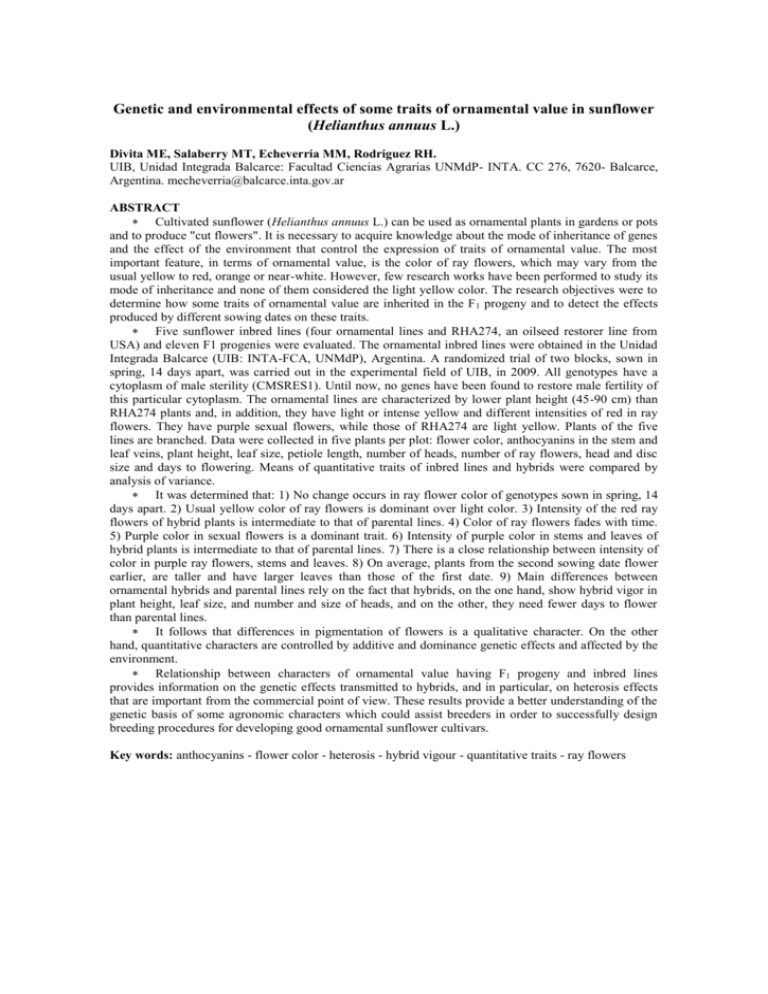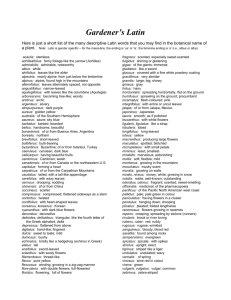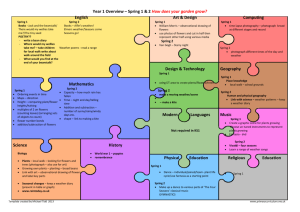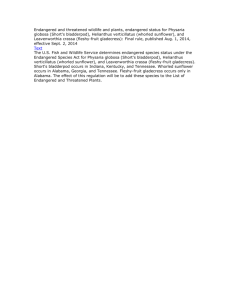Genetic and environmental effects of some traits of ornamental value
advertisement

Genetic and environmental effects of some traits of ornamental value in sunflower (Helianthus annuus L.) Divita ME, Salaberry MT, Echeverría MM, Rodríguez RH. UIB, Unidad Integrada Balcarce: Facultad Ciencias Agrarias UNMdP- INTA. CC 276, 7620- Balcarce, Argentina. mecheverria@balcarce.inta.gov.ar ABSTRACT Cultivated sunflower (Helianthus annuus L.) can be used as ornamental plants in gardens or pots and to produce "cut flowers". It is necessary to acquire knowledge about the mode of inheritance of genes and the effect of the environment that control the expression of traits of ornamental value. The most important feature, in terms of ornamental value, is the color of ray flowers, which may vary from the usual yellow to red, orange or near-white. However, few research works have been performed to study its mode of inheritance and none of them considered the light yellow color. The research objectives were to determine how some traits of ornamental value are inherited in the F 1 progeny and to detect the effects produced by different sowing dates on these traits. Five sunflower inbred lines (four ornamental lines and RHA274, an oilseed restorer line from USA) and eleven F1 progenies were evaluated. The ornamental inbred lines were obtained in the Unidad Integrada Balcarce (UIB: INTA-FCA, UNMdP), Argentina. A randomized trial of two blocks, sown in spring, 14 days apart, was carried out in the experimental field of UIB, in 2009. All genotypes have a cytoplasm of male sterility (CMSRES1). Until now, no genes have been found to restore male fertility of this particular cytoplasm. The ornamental lines are characterized by lower plant height (45-90 cm) than RHA274 plants and, in addition, they have light or intense yellow and different intensities of red in ray flowers. They have purple sexual flowers, while those of RHA274 are light yellow. Plants of the five lines are branched. Data were collected in five plants per plot: flower color, anthocyanins in the stem and leaf veins, plant height, leaf size, petiole length, number of heads, number of ray flowers, head and disc size and days to flowering. Means of quantitative traits of inbred lines and hybrids were compared by analysis of variance. It was determined that: 1) No change occurs in ray flower color of genotypes sown in spring, 14 days apart. 2) Usual yellow color of ray flowers is dominant over light color. 3) Intensity of the red ray flowers of hybrid plants is intermediate to that of parental lines. 4) Color of ray flowers fades with time. 5) Purple color in sexual flowers is a dominant trait. 6) Intensity of purple color in stems and leaves of hybrid plants is intermediate to that of parental lines. 7) There is a close relationship between intensity of color in purple ray flowers, stems and leaves. 8) On average, plants from the second sowing date flower earlier, are taller and have larger leaves than those of the first date. 9) Main differences between ornamental hybrids and parental lines rely on the fact that hybrids, on the one hand, show hybrid vigor in plant height, leaf size, and number and size of heads, and on the other, they need fewer days to flower than parental lines. It follows that differences in pigmentation of flowers is a qualitative character. On the other hand, quantitative characters are controlled by additive and dominance genetic effects and affected by the environment. Relationship between characters of ornamental value having F1 progeny and inbred lines provides information on the genetic effects transmitted to hybrids, and in particular, on heterosis effects that are important from the commercial point of view. These results provide a better understanding of the genetic basis of some agronomic characters which could assist breeders in order to successfully design breeding procedures for developing good ornamental sunflower cultivars. Key words: anthocyanins - flower color - heterosis - hybrid vigour - quantitative traits - ray flowers INTRODUCTION Cultivated sunflower (Helianthus annuus L.) can be used as ornamental plants with other species of the same genus, in gardens, pots or as “cut flowers". Ornamental sunflowers are considered by Heiser et al. (1969) a usually polycephalic cultivated form of H. annuus ssp. annuus. The most significant feature as regards its ornamental value lies in the color of ray flowers which may be red, pink, ocher, orange, yellow among others (Miller and Fick, 1997; Zhang et al., 2008). Most scientific papers studying the inheritance of color in ray flowers indicate that this character is governed by few genes with major effects (Fick, 1976; Secerov-Fiser and Skoric, 1988, cited by Miller and Fick, 1997; Yue et al., 2008). Scientific literature considers that there are different types of yellow in ray flowers: intense yellow, which is the most frequent in the genus Helianthus, lemon and orange (Fick, 1976). White is also a possible color (Zhang et al., 2008). On the other hand, sexual sunflowers may be purple or light yellow. Skaloud and Kovacik (1978) found that purple was a dominant color. At Unidad Integrada Balcarce (UIB): Facultad de Ciencias Agrarias, Universidad Nacional de Mar del Plata – Instituto Nacional de Tecnología Agropecuaria, Argentina, a breeding plan is carried out. Based on a population introduced from the Germplasm Bank in Iowa, USA, some inbred lines with varied colors were achieved. Some of these lines have a light yellow color in ray flowers, different from those already cited in the scientific literature. All lines received dwarf genes from a different population and a cytoplasm producing male sterility called CMSRES1 and detected in some plants of Helianthus resinosus (Rodríguez and Pereyra, 1993). To date, restorer genes of male fertility in plants having this particular cytoplasm have not been found in cultivated sunflower; this is why all plants having this cytoplasm do not produce pollen (Echeverría, 2005). Knowledge on the mode of inheritance of genes and environmental effects, controlling the expression of traits giving an ornamental value to sunflower, enables the choice of the most efficient methodology to produce genotypes combining the desired characters. The relationship between the characters of ornamental value having the F 1 progeny and inbred lines provides information on the genetic effects that are transmitted to hybrids and in particular, on heterosis effects, that are important from the commercial point of view. The aim of this study was to determine the genetic effects of some traits of ornamental value in sunflowers transmitted to F1 progeny, and to detect the effects produced on these characters by the time of sowing. MATERIALS AND METHODS During summer 2008/9, a trial was performed to evaluate five sunflower inbred lines with different features and eleven F1 which had resulted from crossing these lines in different combinations. Of these five lines, four (named 100, 200, 500 and 600) had been produced at UIB to be used as ornamental plants, and the fifth (RHA274) was produced in the USA, to be used in breeding plans for hybrid seed production. Lines 100 and 600 have been registered as cultivars at the Instituto Nacional de Semillas, Argentina, under the names of Floral 100 INTA and Floral 600 INTA. The five inbred lines have a cytoplasm of male sterility (CMSRES1), that is, plants may not have pollen. Neither should hybrids since they had inherited the male sterility cytoplasm by their female progenitor. The trial, designed in two randomized blocks, was carried out in the UIB experimental field (37°45’S – 58°18’W), on a typical Arguidol soil. In the previous summer, the necessary seeds to carry out the trial had been obtained. The amount of F 1 seeds produced determined the number of blocks carried out. The four ornamental inbred lines do not produce many seeds because they have few sexual flowers. Blocks were sown on two dates: November 18 and December 1. Each block consisted of 22 plots; inbred line plants grew in five plots, and different F1 progenies from eleven combinations between inbred lines grew in the remaining 17 plots. Thus, from six combinations, two F 1 progenies were assessed. All possible combinations of parental lines were evaluated without considering the totality of reciprocal crosses. Each plot in the trial consisted of a 5 meters long row. Plants grew at 30 cm within rows and at 70 cm spacing between rows. Data of different traits for which lines differ were collected on five plants per row: color of flowers, sexual as well as ray flowers; the presence of purple pigmentation, both in stems and veins; height of plant, at emergence of first and main head as well as maximum height reached by plants; width and length of two central leaves and length of their petioles; total diameter and that of the disc in the main head and in two secondary heads; number of heads; number of ray flowers; days from emergence to flowering, both for main head and for first secondary heads. Since the central disc increases its size, diameter of heads was recorded before completion of rings of sexual flowers. A variance analysis was performed on quantitative data, with subsampling, and the means were compared by the test of the Least Significant Difference. The coefficient of genetic variation was calculated as a percentage (CVg %) of each character assessed. RESULTS AND DISCUSSION As expected, both plants of inbred lines and those of hybrids were male sterile, that is, they did not produce pollen. 1. Qualitative character: Color The yellow color in ray flowers results from the presence of carotenoids in chromoplasts (Yue et al., 2008) and red or purple results from anthocyanins (Miller and Fick, 1997). Since yellow and red are given by the presence of a different type of pigment, it seems logical that the mode of inheritance of each color should be studied separately. Colors in parental lines of these flowers are formed by combinations of yellow (Y) and red (R), in light (L) or intense (I) versions which could be characterized as follows: 100: LY + LR 200: LY + IR 500: LY + LR 600: IY + LR RHA274: IY It was noted that colors fade with time, especially red. In general, the red pigmentation appears at the base of ray flowers giving the head an aspect of a central halo called “gaillardia” (Fick, 1976). When observing hybrid ray flowers, it was noted that intense yellow is dominant over light yellow. On the other hand, the intensity of the red color in ray flowers of hybrid plants is intermediate among parental lines. The four ornamental inbred lines have intense red or purple sexual flowers, that is, they have anthocyanins. By contrast, in inbred line RHA274 sexual flowers are light yellow, that is, there is absence of the pigment. All hybrid plants produced by crossings between the four ornamental lines and line RHA274 had purple ray flowers, certifying that this color is a dominant character in these genotypes. All four ornamental lines show the purple color of anthocyanins in stems and leaves; line 200 evidences the highest intensity in all its organs. It must be noted that veins in the leaves of this inbred line are purple. To the naked eye, hybrid plants had an intermediate red in stems and petioles, between the colors their progenitors had in the same organs. None of F 1 progenies of inbred line 200 had purple veins in their leaves. In general, it was observed that there is an important relationship between the intensity of the purple color in ray flowers and that in vegetative organs. Some authors have stated that intense yellow is dominant over orange and lemon (Fick, 1976, Skaloud and Kovasik 1978, Secerov-Fiser and Skoric 1988, cited by Miller and Fick, 1997; Yue et al. 2008). Thus, from the available literature and results in this research work, it may be proposed that intense yellow, the most frequent color, is a dominant character over any other shade of this color. Skaloud y Kovacik (1978) detected three dominant genes governing the purple color in sexual flowers of the studied sunflower genotypes. Based on their work on ray flowers, Zhang et al. (2009) could clone six genes involved in the synthesis of anthocyanins. The latter scientists detected that transcripts of these genes were also present in sexual flowers, leaves and stems of sunflower plants; they also found that the maximum expression of genes appeared at the moment of full display of head, with a subsequent decrease. This fact may explain the loss of intensity in the red color of ray flowers, also observed in genotypes evaluated at the UIB. On the basis of the recorded literature and our own results, it may be stated that the anthocyanin level, producing the red or purple of ray flowers in plants of F 1 progeny, is intermediate to the level of their parental lines, and is also a trait affected by the environment after flowering. Considering the purple color of sexual flowers, our results and former literature have demonstrated it is a dominant character, rarely affected by the environment. 2. Quantitative characters In general, plants generated from late sowing were taller at the moment the first head flowered, and leaves were larger. As regards characters, a significant interaction was noted between genotypes and sowing dates, except for the diameter of secondary heads, indicating that, taking into consideration the time of sowing, the response of genotypes for growth of plants was not always the same. Sadras et al. (2009) stated that temperature, photoperiod, water and nitrogen availability, quality of light, CO2 concentration and solar radiation are factors that can affect the development of sunflower plants. However, floral initiation mainly depends on temperature and photoperiod. The entire range of possible responses to photoperiod is found in different sunflower seed producing cultivars (Goyne and Schneiter, 1988; León et al., 2000). Studying the effects of photoperiod on different cultivars of ornamental sunflower, Hayata and Imaizumi (2000) and Yáñez et al. (2004) concluded that genotypes may require different day length to promote flowering. Taking into account the former statements, it may be a fact that different photoperiods and environmental temperatures had different effects on plants grown in the two blocks planted with a 14-day difference. Differences between genotypes were observed in all quantitative traits evaluated. Ornamental lines varied mainly in relation to the height of plants at emergence of first head (36-86 cm), final height (47-90 cm), and number of heads (7-19). Plants of the line RHA274 differed mainly for being taller and having a bigger main head, with more ray flowers than ornamental plants. This inbred line took more days to flower than ornamental ones. According to the CVg% (Table), number of days until flowering, for the main head as well as for secondary heads, was the character which showed less variation between genotypes, inbred lines and hybrids; following character was size of heads. It is therefore considered that genotype variability expressed in the rest of the characters has been relatively broad, especially in heads (86.4%) produced by genotypes. Table: Means of F1 and inbred lines and coefficient of genetic variation (CVg) in traits of ornamental sunflower. Traits F1 (*) Inbred Lines (*) Height to main head (cm) 89.5 a 66.2 b Height of plant (cm) 105.1 a 73.2 b Length of leaf (cm) 17.5 a 14.8 b Width of leaf (cm) 14.4 a 12.3 b Length of petiole (cm) 12.6 a 9.8 b Diameter of main head (cm) 15.8 a 13.8 b Disc diameter of main head (cm) 6.4 a 5.8 b Diameter of secondary head (cm) 13.1 a 11.2 b Disc diameter of secondary heads (cm) 5.1 a 4.5 b Number of heads 13.9 a 11.4 a Number of ray flowers 36.3 a 35.3 a Days to flowering of main head 42.8 a 45.5 b Days to flowering of secondary heads 50.9 a 54.7 b (*) Equal letters indicate absence of significant difference between means (P>0.05) CVg (%) 55.0 41.9 46.4 45.4 53.2 20.2 17.6 34.4 31.9 86.4 45.4 15.4 7.6 Hybrid plants were taller in average, both when considered height at main head as at final height; they had larger leaves with longer petioles and bigger heads than parental lines (Table). In some cases, hybrids exceeded both parental lines and, in others, they exceeded the average value between both progenitors, even if not reaching that of one of them. In addition to the larger size, hybrid plants flowered, on average, three days before inbred lines. No differences were registered in relation to the number of heads and ray flowers between hybrids and parental inbred lines. However, when only comparing the four ornamental lines and their hybrids, it was demonstrated that the latter had a higher mean number of heads (16) than their parental lines (11.4). It was also shown that the mean height of plants of ornamental lines was lower than that of the hybrids they generated. Moreover, the lower height of ornamental inbred lines derived from other plants, with the same trait, originated by selfing of plants of normal height. This would suggest that the lower height in plants associated with this genotype would be a recessive trait governed by more than one gene. The inbred line RHA274 does not have dwarfism genes, thus, it is expected that as a dominance effect, hybrids of this parental line, will have an average height greater than that of their parental lines. This fact agrees with results of the experimental trial. In general, the scientific literature states that the standard height of a sunflower plant is a quantitative trait with additive and dominance genetic effects; for this reason, it is expected that hybrids in general will be taller than the average for their parental lines (Putt, 1966; Lay and Kahn, 1985; Goksoy et al., 2002). Vranceanu (1977), Fick (1978), Berretta de Berger and Miller (1984, cited by Miller and Fick, 1997) and Cecconi et al. (2002) concluded that in some cases, reduced height is controlled by a recessive gene. Nevertheless, when studying three populations of low-height plants, Miller and Hammond (1991) determined that in those populations, this is also a quantitative trait with additive and dominance genetic effects. Unquestionably, there are various sources of reduced height produced by different genes. It may be assumed that in some cases, a single mutation may cause a plant to be short. It has been demonstrated that in cultivated sunflower, F1 progenies show significant heterosis in the diameter of the single head produced, with important additive and non-additive effects (Putt, 1966; Goksoy et al., 2002; Hladni et al., 2003). No scientific record has been found as regards the genetic effects governing the size of heads in branched sunflower plants. Results of this research work indicate there are non-additive genetic effects that, in general, determine the size of heads of branched hybrids evaluated will be larger than their parental lines. When studying the inheritance of number of heads per plant in five inbred lines of ornamental sunflower and their F1 and F2, Seceroy-Fiser (1999) found that in some cases, the progenies were intermediate to their parental lines, and in others, they presented more heads. Results indicated that there are additive and non-additive effects governing this trait. Ornamental genotypes evaluated at the UIB had a similar effect regarding the heterosis effect in the number of heads; this was not detected when line RHA274 and its hybrids were included in the trial. In general, scientists agree as regards the expectation that sunflower hybrids for seed production flower some days before their parental inbred lines, although some hybrids have intermediate flowering dates between those of their parental lines (Putt, 1940; Unrau, 1947; Jan, 1986, all cited by Miller and Fick, 1997; Giussani, 2010). No literature was found as to the relationship between the days for hybrid flowering and those for their parental lines in branched sunflower genotypes. From the abovementioned, it follows that hybrid plants show hybrid vigor with respect to the size of their organs, and they need fewer days than their parental lines for flowering. CONCLUSIONS No change occurs in ray flower color of genotypes sown in spring, 14 days apart. Usual yellow color of ray flowers is dominant over light color. Intensity of the red ray flowers of hybrid plants is intermediate to that of parental lines. Color of ray flowers fades with time. Purple color in sexual flowers is a dominant trait. Intensity of purple color in stems and leaves of hybrid plants is intermediate to that of parental lines. There is a close relationship between intensity of color in purple ray flowers, stems and leaves. On average, plants from the second sowing date flower earlier, are taller and have larger leaves than those of the first date. Main differences between ornamental hybrids and parental lines rely on the fact that hybrids, on the one hand, show hybrid vigor in plant height, number and size of heads and leaves, and on the other, they need fewer days to flower than parental lines. REFERENCES Cecconi, F., M. Gaetani, C. Lenzi, and M. Durante. 2002. The sunflower dwarf mutant dwl: Effects of gibberellic acid treatment. Helia 25:161-166. Echeverria, M.M. 2005. Caracterización genética y agronómica de la androesterilidad citoplásmica RES1 en girasol (Helianthus annuus L.) identificada en la especie silvestre H. resinosus Small. Tesis Doctoral. Facultad de Ciencias Agrarias. Universidad Nacional de Mar del Plata, Argentina. Fick, G.N. 1976. Genetics of floral color and morphology in sunflowers. J. Heredity 67:227-230. Fick, G.N. 1978. Sunflower breeding and genetics. p. 279-337.In: J.F. Carter (ed.) Sunflower science and technology. Agronomy Monography 19. ASA, CSSA y SSSA, Madison WI, USA. Giussani, A. 2010. Caracterización de líneas restauradoras de girasol por su comportamiento a Sclerotinia sclerotiorum y otros caracteres de interés agronómico. Tesis M. Sc. Facultad de Ciencias Agrarias. Universidad Nacional de Mar del Plata, Argentina. Goksoy, A.T., A. Turkec, and Z. M. Turan. 2002. Determination of some agronomic characteristics and hybrid vigor of new improved synthetic varieties in sunflower (Helianthus annuus L.). Helia 25):119-130. Goyne, P.J., and A.A. Schneiter. 1988. Temperature y photoperiod interactions with the phonological development of sunflower. Agronomy J. 80: 777-784. Hayata Y., and Y. Imaizumi. 2000. Effect of photoperiod on flower bud development of ornamental sunflower (Helianthus annuus L.). J. Japanese Soc. Hort. Sci 69:708-710. Heiser, C.B., D.M. Smith, S.B. Clevenger, and W.C. Martin. 1969. The North American sunflowers (Helianthus). Memoirs of the Torrey Botanical Club 22:1-218. Hladni, N., D. Škorić, and M. Kraljević-Balalić. 2003. Components of phenotypic variability for head diameter in sunflower (Helianthus annuus L.). Genetika 35:67-75. Lay, C.L., and S.F. Khan. 1985. Inheritance of plant height in six sunflower crosses. p. 721-725. In: Proc. 11th Int. Sunflower Conf., Mar del Plata, Argentina. Int. Sunfl. Assoc., Paris, France. León, A.J., M. Lee, and F.H. Andrade. 2000. Genetic mapping as factors affecting quantitative variation for flowering in sunflower. Crop Sci. 15:404-407. Miller, J., and G.N. Fick. 1997. The genetics of sunflower. p. 491-495. In: A.A. Schneiter (ed.) Sunflower technology and Production. Agronomy Monography 35. ASA, CSSA and SSSA, Madison, WI, USA. Miller, J.F., and J. J. Hammond. 1991. Inheritance of reduced height in sunflower. Euphytica 53:131-136. Putt, E.D. 1966. Heterosis, combining ability, and predicted synthetics from a diallel cross in sunflowers (Helianthus annuus L.). Canadian J. Plant Sci. 46:59-67. Rodríguez, R.H., y V. R. Pereyra. 1993. Androesterilidad citoplásmica en la descendencia de híbridos interespecíficos entre Helianthus resinosus Small y H. annuus L. p. 81. En: Resúmenes 24º Congreso Argentino de Genética, Posadas, Argentina. Sadras, V.O., M. A. Ferreiro, F. Gutheim, and A.G. Kantolic. 2009. Desarrollo fenológico y su respuesta a temperatura y fotoperíodo. p 19-39. En: F.H. Andrade; V.O. Sadras (eds.): Bases para el manejo del maíz, el girasol y la soja. Editorial Médica Panamericana S.A, Argentina. Secerov-Fiser. V. 1999. Inheritance of number of heads per plant in ornamental sunflower (Helianthus annuus L.). J. Agric. Sci. 44:21-26. Skaloud, V., and A. Kovasik. 1978. Survey on inheritance of sunflower characters which are conditioned by a small number of genes. p. 490-496. In: Proc. 8th Int. Sunflower Conf., Minneapolis, MN, USA. Int. Sunfl. Assoc., Paris, France. Vranceanu, A.V. 1977. El Girasol. Mundi-Prensa. Madrid. Yañez, P.; H. Ohno and K. Ohkawa. 2004. Effect of photoperiod on flowering and growth of ornamental sunflowers cultivars. Environment Control in Biology 42:287-293. Yue, B., B. A. Vick, W. Yuan, and J. Hu. 2008. Mapping one of the 2 genes controlling lemon ray flower color in sunflower (Helianthus annuus L.). J. Heredity 99:564-567. Zhang, J.L., D.R. Pan, Y.F. Zhou, Z.C. Wang, S.M. Hua, L. Hou, and F. Sui. 2009. Cloning and expression of genes involved in anthocyanins synthesis in ornamental sunflower. Acta Horticulturae Sinica 2009-01. Disponible en http://en.cnki.com.cn/Article_en/CJFDTOTAL-YYXB200901014.htm (verified 5 Apr. 2011). Zhang, Y.Y., D.M. Qi, H. Liu, J.C. Zhang, C.H. Li, J. Zhang, L.S. Wang, and G.S. Liu. 2008. The diversity of flower color of the ornamental sunflower and the relation to anthocyanins. Acta Horticulturae Sinica 2008-06. Disponiblehttp://www.ahs.ac.cn/qikan/manage/wenzhang/6-14.pdf (verified 20 Dec. 2010).









